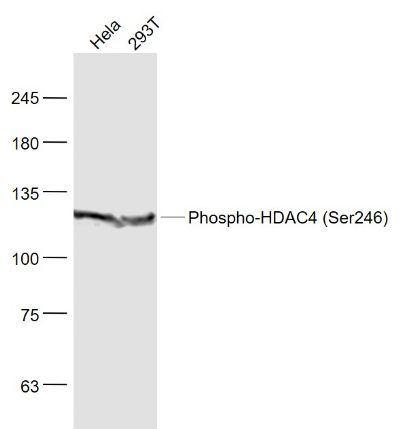产品货号 : mlR10325
英文名称 : Phospho-HDAC4 (Ser246)
中文名称 : 磷酸化组蛋白去乙酰化酶4(Ser246)抗体
别 名 : HDAC4(Phospho-Ser246); HDAC4(Phospho-S246); p-HDAC4(Ser246); p-HDAC4(S246); HD 4; HD4; HDAC 4; HDAC A; HDACA; Histone Deacetylase 4; Histone Deacetylase A; KIAA0288; EC 3.5.1.98; HA6116; HDA4_CAEEL; Histone deacetylase 4; CeHDA-7; Histone deacetylase 7.
产品类型 : 磷酸化抗体
研究领域 : 肿瘤 细胞生物 免疫学 神经生物学 信号转导 细胞凋亡
抗体来源 : Rabbit
克隆类型 : Polyclonal
交叉反应 : Human,
产品应用 : WB=1:500-2000 ELISA=1:500-1000 IHC-P=1:400-800 IHC-F=1:400-800 ICC=1:100-500 IF=1:100-500 (石蜡切片需做抗原修复)
not yet tested in other applications.
optimal dilutions/concentrations should be determined by the end user.
分 子 量 : 119kDa
细胞定位 : 细胞核 细胞浆
性 状 : Lyophilized or Liquid
浓 度 : 1mg/ml
免 疫 原 : KLH conjugated synthesised phosphopeptide derived from human HDAC4 around the phosphorylation site of Ser246:TA(p-S)EP
亚 型 : IgG
纯化方法 : affinity purified by Protein A
储 存 液 : 0.01M TBS(pH7.4) with 1% BSA, 0.03% Proclin300 and 50% Glycerol.
保存条件 : Store at -20 °C for one year. Avoid repeated freeze/thaw cycles. The lyophilized antibody is stable at room temperature for at least one month and for greater than a year when kept at -20°C. When reconstituted in sterile pH 7.4 0.01M PBS or diluent of antibody the antibody is stable for at least two weeks at 2-4 °C.
PubMed : PubMed
产品介绍 : Histones play a critical role in transcriptional regulation, cell cycle progression, and developmental events. Histone acetylation/deacetylation alters chromosome structure and affects transcription factor access to DNA. The protein encoded by this gene belongs to class II of the histone deacetylase/acuc/apha family. It possesses histone deacetylase activity and represses transcription when tethered to a promoter. This protein does not bind DNA directly, but through transcription factors MEF2C and MEF2D. It seems to interact in a multiprotein complex with RbAp48 and HDAC3. [provided by RefSeq, Jul 2008].
Function:
Responsible for the deacetylation of lysine residues on the N-terminal part of the core histones (H2A, H2B, H3 and H4). Histone deacetylation gives a tag for epigenetic repression and plays an important role in transcriptional regulation, cell cycle progression and developmental events. Histone deacetylases act via the formation of large multiprotein complexes. Involved in muscle maturation via its interaction with the myocyte enhancer factors such as MEF2A, MEF2C and MEF2D.
Subunit:
Interacts with HDAC7. Homodimer. Homodimerization via its N-terminal domain. Interacts with MEF2C, AHRR, and NR2C1. Interacts with a 14-3-3 chaperone protein in a phosphorylation dependent manner. Interacts with BTBD14B. Interacts with KDM5B. Interacts with MYOCD. Interacts with MORC2. Interacts with ANKRA2.
Subcellular Location:
Nucleus. Cytoplasm. Note=Shuttles between the nucleus and the cytoplasm. Upon muscle cells differentiation, it accumulates in the nuclei of myotubes, suggesting a positive role of nuclear HDAC4 in muscle differentiation. The export to cytoplasm depends on the interaction with a 14-3-3 chaperone protein and is due to its phosphorylation at Ser-246, Ser-467 and Ser-632 by CaMK4 and SIK1. The nuclear localization probably depends on sumoylation.
Tissue Specificity:
Ubiquitous.
Post-translational modifications:
Phosphorylated by CaMK4 at Ser-246, Ser-467 and Ser-632. Phosphorylation at other residues by CaMK2D is required for the interaction with 14-3-3. Phosphorylation at Ser-350 impairs the binding of ANKRA2 but generates a high-affinity docking site for 14-3-3.
Sumoylation on Lys-559 is promoted by the E3 SUMO-protein ligase RANBP2, and prevented by phosphorylation by CaMK4.
DISEASE:
Brachydactyly-mental retardation syndrome (BDMR) [MIM:600430]: A syndrome resembling the physical anomalies found in Albright hereditary osteodystrophy. Common features are mild facial dysmorphism, congenital heart defects, distinct brachydactyly type E, mental retardation, developmental delay, seizures, autism spectrum disorder, and stocky build. Soft tissue ossification is absent, and there are no abnormalities in parathyroid hormone or calcium metabolism. Note=The disease is caused by mutations affecting the gene represented in this entry.
Similarity:
Belongs to the histone deacetylase family. HD type 2 subfamily.
SWISS:
P56524
Gene ID:
9759
Important Note:
This product as supplied is intended for research use only, not for use in human, therapeutic or diagnostic applications.
产品图片












